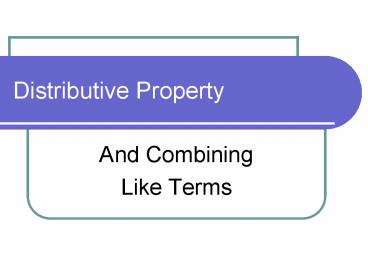Distributive Property - PowerPoint PPT Presentation
1 / 13
Title:
Distributive Property
Description:
IN THE DISTRIBUTIVE PROPERTY ONE OF MY FRIENDS IN THE ... Linda is planning a party for her best friend. ... What was the cost for these party supplies? ... – PowerPoint PPT presentation
Number of Views:2686
Avg rating:3.0/5.0
Title: Distributive Property
1
Distributive Property
- And Combining
- Like Terms
2
THE NUMBER OUTSIDE THE PARENTHESES IS SUPPOSED TO
BE MULTIPLIED BY BOTH TERMS INSIDE THE
PARENTHESES, BUT MANY PEOPLE FORGET TO INCLUDE
MY FRIEND, THE SECOND TERM, WHEN THEY MULTIPLY
THE TERMS TOGETHER.
HAVE YOU EVER FELT LEFT OUT? IN THE DISTRIBUTIVE
PROPERTY ONE OF MY FRIENDS IN THE PARENTHESES
KNOWS EXACTLY HOW YOU FEEL.
3
What did I do wrong?
- Many people think this is the correct answer to
this problem - 5(x 1) 5x 1
- The way to solve this is to multiply both terms
inside the parentheses by the number outside the
parentheses. - 5(x 1) 5(x) 5(1)
- The correct answer is 5x 5
4
LETS SOLVE A PROBLEM
5( 3 9)
- USE THE
- DISTRIBUTIVE PROPERTY OF MULTIPLICATION
- OVER ADDITION
- BY ADDING
- (3 9)5 12 5 SO
- 5(3) 5(9) 60
5
Real World Examples
- Linda is planning a party for her best friend.
She buys 3 packs of cups for 1.99, 3 packs of
forks for 2.19, 3 packs of plates for 2.49, and
3 packs of knives for 2.19. - What was the cost for these party supplies?
- What would be the final cost if the store charges
6 tax?
6
Examples
- Modeling the Distributive Property using
- Algebra Tiles
- This 1 cm by 1 cm The area of this
- square has an area rectangle is x by 1 or
- of 1 sq. unit x sq. units
X - tile
x
1
1 - tile
1
1
7
Solving 5(x 1) using Distributive Property and
Algebra Tiles
5
5
5
x
1
x 1
Area 5(x 1) Area 5(x) 5(1) The
area is 5x 5 square units
8
Lets Practice!!
- 3(x - 2)
- Now you do some.
- 1) 4 (x 3)
- 7(x 2)
- 3(x 5)
- 5(x 3)
- 2(x 4)
3
X - 2 The product of this problem is 3x - 6
9
Like Terms
- Like terms have the same variable and the same
exponent. - When combining like terms, you add the
coefficients of the terms. A term with no
variable is called a constant. Two constants in
the same expression are also like terms. - In the example 12y 4y 3
- coefficient constant
10
Adding Like Terms
- (3 5)
- You can combine these because they are like
terms. - (x 5)
- You can not combine because they arent like
terms.
11
More Examples
- x 12 4x (Understood coefficient)
- (1 4)x 12 5x 12
- -(3x 7) 5x
- Distribute the negative one first, so your
problem becomes -3x 7 5x - (-3 5)x 7 2x - 7
12
How would you solve these problems?
- 15x 11x 3
- Combine like terms
- (15 11)x - 3 26x 3
- 12x 3y - 4x
- Unlike terms cant combine an x and a y
- (12 4)x 3y 8x 3y
13
Show us your stuff!!
- Simplify these expressions.
- 1) 8y 4y
- 2) 9a 4b a
- 3) 8r 2b 6r 4b
- 4) -12x 2 6x
- 5) 2(x 5) 7x
- You did great!!

